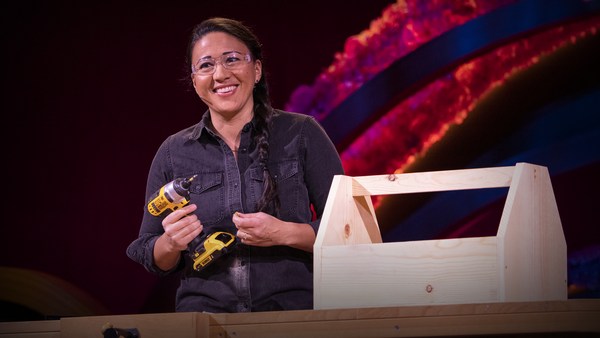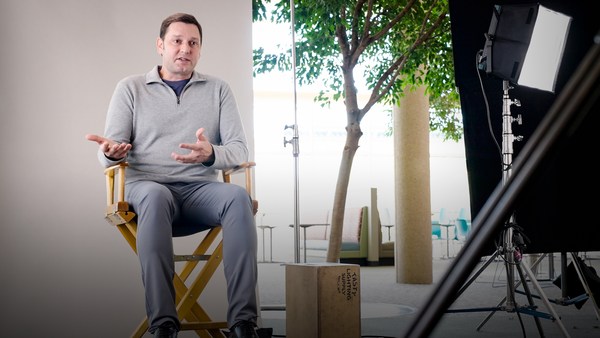I am a repair geek. I grew up fixing things with my dad; it was what we did. We fixed our TV, we fixed our refrigerator, we fixed stuff that didn't need fixing. We fixed our Volkswagen Beetle. In our home, if something broke, we took it as an opportunity to have fun. We loved the idea and the challenge of bringing things back to life. And I still love that feeling, which to me is just thrilling. I did it recently. My laptop was overheating, I thought it might be the fan, I ordered a fan, I put the fan in, I turned it on, and the fan went "whir" like, “Yes! That really worked.” It was a great feeling.
Now I know this kind of repair probably sounds very old-fashioned, and I probably look a little old-fashioned, but it's much more than saving money. It's how we keep the things that we like in use. It helps us keep things out of the trash. It helps bring jobs into our communities, and it can help solve the digital divide.
Now, since 2013, I've been the executive director of the Digital Right to Repair Coalition, otherwise known as repair.org. Our members do all the Rs: We repair, we reuse, we resell and we recycle. And in doing this work, I've come to realize that repair is right now central to all of our sustainability goals. If we can fix our stuff a little more frequently, keep it in use, we're keeping it out of the front of the waste stream at the front end. So we'll have less to process at the back end. If we are going to have any control over our e-waste problem, we have to talk about repair.
Let me give you a sense of scale. Back in 2013, the EPA estimated that the average US household already owned 28 digitally-driven gizmos and gadgets. It was everything from garage-door openers and hot tub controls to smart toasters. If we just do a little math and multiply 28 times are roughly 123 million households, we come up with a pretty staggering three and a half billion pieces of e-waste that don't belong in our landfills, and they are costly and difficult to put back as raw materials if those processes even exist. When we look a little more closely at what's even possible with recycling, I think we've been ignoring some really ugly truths. By the time a laptop or a refrigerator or even an electric toothbrush gets in our hands, almost all of the environmental damage has already been done. All the costs of mining and refining and smelting and transportation. And we don't see these costs when we go to the store, and we don't see the human costs of terrible labor conditions and exposure to toxic materials. So even if we can't agree on how to calculate these costs, I think we can agree that fixing more and throwing away less just makes sense.
There's a lot of other advantages of repairing things other than just the obvious. Repair is what lets us keep our older devices in use, and it allows a secondary market for the products that we want to resell. And secondary markets are why used equipment is so affordable because the used seller has to compete with new. So if a new gadget is 1,000 dollars, we expect a pretty big discount to buy that same item used. Let's start with 50 percent. So now we have an affordability capability that is central to crossing the digital divide. We had five million students that went to virtual school this past year that didn't have enabling technology. And that's because parents and school districts couldn't buy new. We still have a lot of chip shortages, and these are going to be with us for a while. And I think we have to think very seriously about doing more repair, not just to make things last longer but also to be more resilient as an economy. Repair is also a point of entry for a lot of our engineers and innovators. I heard Steve Wozniak speak very recently -- Apple Steve Wozniak -- He spoke very recently about his growth and development at a time when he was repairing things as a kid. And it was central to his development as an engineer. He grew up pretty much the same time I did, where repairs were very ordinary. Consumers were empowered to take their vacuum tubes to the local store, plug them in and see if they work and then buy a replacement on the spot. And there were lots of options for repair within the community to help with the more difficult challenges. I think you've probably noticed that these mom and pop businesses disappeared or all but disappeared in our communities. And it’s not because we don’t want to fix our stuff, it's because they were not allowed to buy the essential repair materials that enabled them to stay in business. So if we can back that back and make it possible for our local repair shops to buy parts and tools, then those businesses will come back and they will bring back with them jobs that feed families. And our nerdy kids will be able to open things up, figure out how they work and become the engineers and innovators of our future.
Repair jobs, which I mentioned, they’re great jobs, and they don't require an advanced degree. I'll give you an example. There's a charity in Minnesota called Tech Dump, and they take in donated electronics, and then they hire adults that are hard to employ, many of whom coming out of the criminal justice system. They train them to make repairs. They then take the repaired goods, sell them and use the proceeds to fund more training. They’re keeping equipment out of the waste stream; they’re bringing good-quality equipment to their community in a used format; and they are bringing people out of poverty and into the workforce.
What's really got me irritated (Laughs) is that at this point, the vast majority of products on the market today cannot be repaired by any party without being totally dependent on the manufacturer. And the day the manufacturer decides they don't want you to fix it, it's over. This is a completely artificial problem. Manufacturers used to provide comprehensive documentation and schematics and shipped it with every product. It was expected that you could fix your stuff. Then once the internet allowed this documentation to be hosted online, manufacturers stopped printing, which made sense because printing was expensive. And then somewhere along the line, somebody said, "Ah, we need to know who's using our website." So they demanded a login. And then another bright light said, "Oh, we can charge." So they put up a paywall. And then a third bright light said, "We can't let anybody have this information at all. They might compete with us." And that's where we are today. We can't get what we need to fix our stuff.
Now, I can tell you because I've had a front-row seat, this trend towards a throwaway economy is reversing all over the world. And it's really fun to be able to tell you about it. Back in 2014, we put forward our very first digital “Right to Repair” bill, and that became the template for dozens of other bills. And this year, we've had 27 states take up the same legislation. These bills are starting to pass. There's been a lot of help from the Federal Trade Commission and also the Biden administration, in saying we really, as a country, need to be able to fix our stuff, and we need competition for repair. It's not just us. Canada and Australia have got similar processes underway. The European Union has put forward a set of regulations that just took effect that are limiting the use of adhesives in the construction of products because if you can't get into the thing, you can't fix the thing. France has yet another idea. They are requiring manufacturers to rate themselves on their repairability, and then they are posting those scores for consumers to consider pre-purchase. There are groups forming up all over the world that help people repair stuff even without government or regulatory change. You may have seen Repair Cafés advertised in your community. That first Repair Café started in 2009 in Denmark. There are now over 2,000 official chapters. There are web sites, YouTube and a company called ifixit.com that hosts tens of thousands of repair tutorials to help people learn how to fix their stuff. Last year, they recorded 116 million unique users on their website, so I think it's pretty clear people do want to fix their stuff.
So I'm very encouraged by the fact that our throwaway economy, the trend is reversing. And we are going to be able to fix our stuff. We're going to be able to use the things we want in the way that we want them. We will be able to cross the digital divide, and we will have more jobs, and we will all get that great “Yes! I fixed it!” feeling.
So the next time something around you breaks, don't take "broken" for an answer. Go fix something.
(Applause)
Thank you.





